A Laboratory Study on the Shear Strength Behavior of Two Till Deposits from Northern Germany
Abstract
1. Introduction
2. Experimental Program
2.1. Tested Soils
2.2. Equipment Used
2.3. Experimental Procedure
3. Results and Discussion
3.1. Saturation Phase Plots
3.2. Consolidation Phase Plots
3.3. Shearing or Loading Phase Results
4. Conclusions
Author Contributions
Funding
Institutional Review Board Statement
Informed Consent Statement
Data Availability Statement
Acknowledgments
Conflicts of Interest
References
- Hambrey, M.J. Glacial Environment; University College Press: London, UK, 1994. [Google Scholar]
- Bell, F.G. The geotechnical properties of some till deposits occurring along the coastal areas of eastern England. Eng. Geol. 2002, 63, 49–68. [Google Scholar] [CrossRef]
- Lampe, R. Pleistocene and Holocene Evolution of Coastal NE Germany (Isle of Rügen). In From the northern ice shield to the Alpine Glaciations; Sauer, D., Ed.; Deutsche Quartärvereinigung e.V., Geozon Science Media: Greifswald, Germany, 2011; pp. 6–18. [Google Scholar]
- LLUR. Geologische Übersichtskarte von Schleswig-Holstein; Landesamt für Landwirtschaft, Umwelt und ländliche Räume (LLUR): Flintbek, Germany, 2012. [Google Scholar]
- Hughes, D.B.; Clarke, B.G.; Money, M.S. The glacial succession in lowland northern England. Q. J. Engng Geol. 1998, 31, 211–234. [Google Scholar] [CrossRef]
- Cui, Y.J.; Sultan, N.; Delage, P. A thermomechanical model for saturated clays. Can. Geotech. J. 2000, 37, 607–620. [Google Scholar] [CrossRef]
- Burghignoli, A.; Desideri, A.; Miliziano, S. A laboratory study on the thermomechanical behaviour of clayey soils. Can. Geotech. J. 2000, 37, 764–780. [Google Scholar] [CrossRef]
- Abuel-Naga, H.M.; Bergado, D.T.; Lim, B.F. Effect of temperature on shear strength and yielding behavior of soft Bangkok clay. Soils Found. 2007, 47, 423–436. [Google Scholar] [CrossRef]
- Hueckel, T.; François, B.; Laloui, L. Explaining thermal failure in saturated clays. Géotechnique 2009, 59, 197–212. [Google Scholar] [CrossRef]
- Slegel, D.L.; Davis, L.R. Transient heat and mass transfer in soils in the vicinity of heated porous pipes. J. Heat Transf. 1977, 99, 541–621. [Google Scholar] [CrossRef]
- Moritz, L. Geotechnical properties of clay at elevated temperatures. In Proceedings of the International Symposium on Compression and Consolidation of Clayey Soils, IS-Hiroshima, Japan, 10–12 May 1995; Balkema: Rotterdam, The Netherlands, 1995; pp. 267–272. [Google Scholar]
- Abdel-Hadi, O.N.; Mitchell, J.K. Coupled heat and water flows around buried cables. J. Geotech. Engrg. Div. Asce 1981, 107, 1461–1487. [Google Scholar] [CrossRef]
- Gera, F.; Hueckel, T.; Peano, A. Critical issues in modelling of the long-term hydro-thermal performance of natural clay barriers. Engrg. Geol. 1996, 41, 17–33. [Google Scholar] [CrossRef]
- Uchaipichat, A.; Khalili, N. Experimental investigation of thermo-hydro-mechanical behaviour of an unsaturated silt. Géotechnique 2009, 59, 339–353. [Google Scholar] [CrossRef]
- Laloui, L. Thermo-mechanical behaviour of soils. Rev. Française Génie Civ. 2001, 5, 809–843. [Google Scholar] [CrossRef]
- Campanella, R.G.; Mitchell, J.R. Influence of temperature variations on soil behavior. J. Soil Mech. Found. Div. Asce 1968, 94, 709–734. [Google Scholar] [CrossRef]
- Demars, K.R.; Charles, R.D. Soil volume changes induced by temperature cycling. Can. Geotech. J. 1982, 19, 188–194. [Google Scholar] [CrossRef]
- Desideri, A. Determinazione Sperimentale dei Coefficienti di Dilatazione Termica Delle Argille. In Proceedings, Convegno del Gruppo Nazionale di Coordinamento per gli Studi di Ingegneria Geotecnica sul tema: Deformazioni dei Terreni ed Interazione Terreno-Struttura in Condizioni di Esercizio, Monselice, Italy, 5–6 October 1988; CNRIG: Lecco, Italy, 1988; Volume 1, pp. 193–206. [Google Scholar]
- Miliziano, S. Influenza della Temperatura sul Comportamento Meccanico delle Terre Coesive. Tesi di Dottorato in Ingegneria Geotecnica. Ph.D. Thesis, Università di Roma “La Sapienza”, Rome, Italy, 1992. [Google Scholar]
- Towhata, I.; Kuntiwattanaul, P.; Seko, I.; Ohishi, K. Volume change of clays induced by heating as observed in consolidation tests. Soils Found. 1993, 33, 170–183. [Google Scholar] [CrossRef]
- Baldi, G.; Hueckel, T.; Pellegrini, R. Thermal volume changes of the mineral–water system in low-porosity clay soils. Can. Geotech. J. 1988, 25, 807–825. [Google Scholar] [CrossRef]
- Stephan, H.-J. Exkursionsführer Heiligenhafener ‘Hohes Ufer’. Geschiebesammler 1985, 18, 83–99. [Google Scholar]
- van der Wateren, F.M. Structural geology and sedimentology of the Heiligenhafen till section, Northern Germany. Quat. Sci. Rev. 1999, 18, 1625–1639. [Google Scholar] [CrossRef]
- Stephan, H.-J. The Heiligenhafen Cliff. In Quaternary Field Trips in Central Europe. International Union for Quaternary Research, XIV Congress, Berlin, Germany; Schirmer, W., Ed.; Pfeil: Munich, Germany, 1995; Volume 1: Regional Field Trips; pp. 46–47. [Google Scholar]
- ASTM D420–D5876. Soil and Rock (I); ASTM International: West Conshohocken, PA, USA, 2011. [Google Scholar]
- DIN 18123. Soil, Investigation and Testing; Determination of grain-size distribution; Deutsches Institut für Normung e.V. (DIN): Berlin, Germany, 1996. (In German) [Google Scholar]
- ASTM D7181. Standard Test Method for Consolidated Drained Triaxial Compression Test for Soils; ASTM International: West Conshohocken, PA, USA, 2020. [Google Scholar]
- Head, K.H. Effective Stress Tests. Manual of Soil Laboratory Testing, 2nd ed.; Wiley: West Sussex, UK, 1998; Volume 3. [Google Scholar]
- Stipp, M.; Rolfs, M.; Kitamura, Y.; Behrmann, J.H.; Schumann, K.; Schulte-Kortnack, D.; Feeser, V. Strong sediments at the deformation front, and weak sediments at the rear of the Nankai accretionary prism, revealed by triaxial deformation experiments. Geochem. Geophys. Geosystems 2013, 14, 4791–4810. [Google Scholar] [CrossRef]
- Hashimoto, Y.; Stipp, M.; Lewis, J.C.; Wuttke, F. Paleo-stress orientations and magnitudes from triaxial testing and stress inversion analysis in Nankai accretionary prism sediments. Prog. Earth Planet. Sci. 2019, 6, 3. [Google Scholar] [CrossRef]
- DIN 18137. Soil, Testing Procedures and Testing Equipment; Determination of Shear Strength: Triaxial Test, Part 2; Deutsches Institut für Normung e.V. (DIN): Berlin, Germany, 2020. (In German) [Google Scholar]
- SCDOT. Geotechnical Design Manual, Chapter 7: Geomechanics, 2nd ed.; South Carolina Department of Transportation (SCDOT): Columbia, SC, USA, 2019. [Google Scholar]
- Carter, M.; Bentley, S.P. Soil Properties and Their Correlations, 2nd ed.; Wiley: West Sussex, UK, 2016. [Google Scholar]

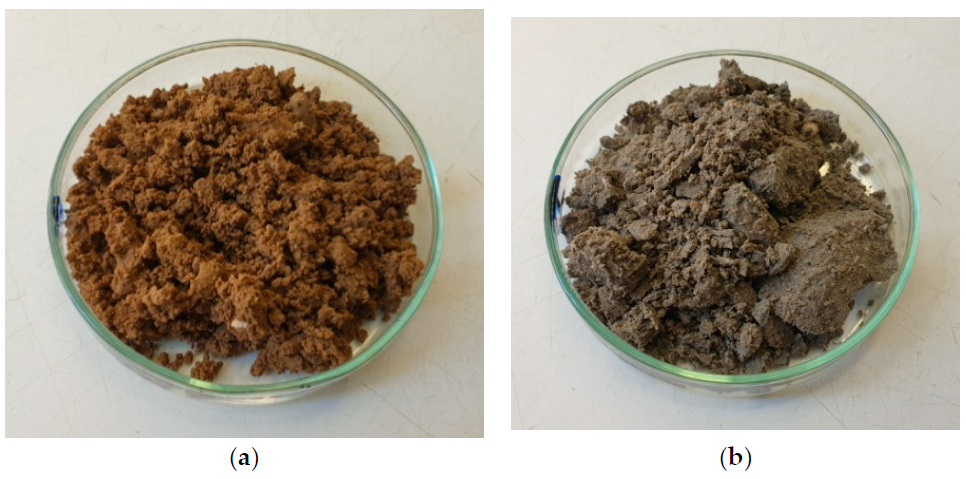
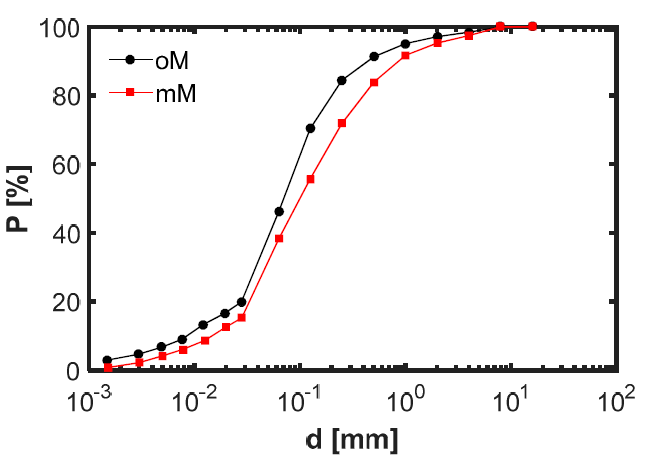



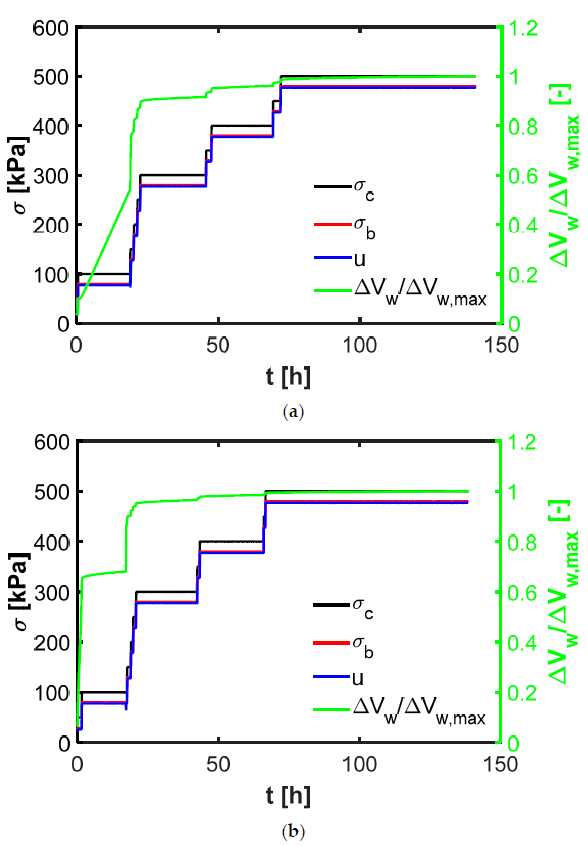
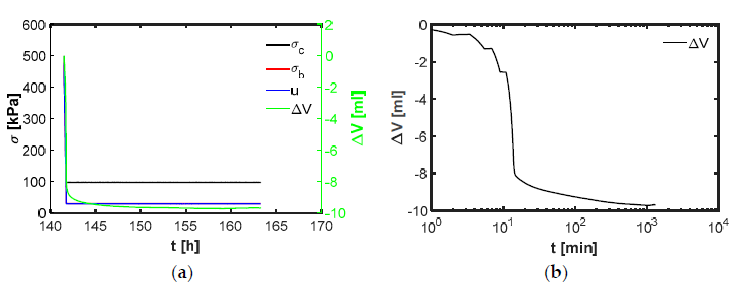
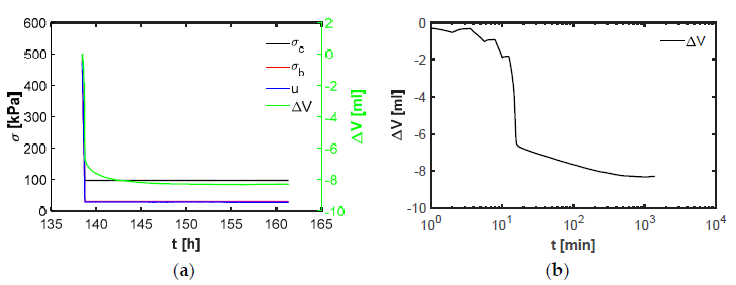
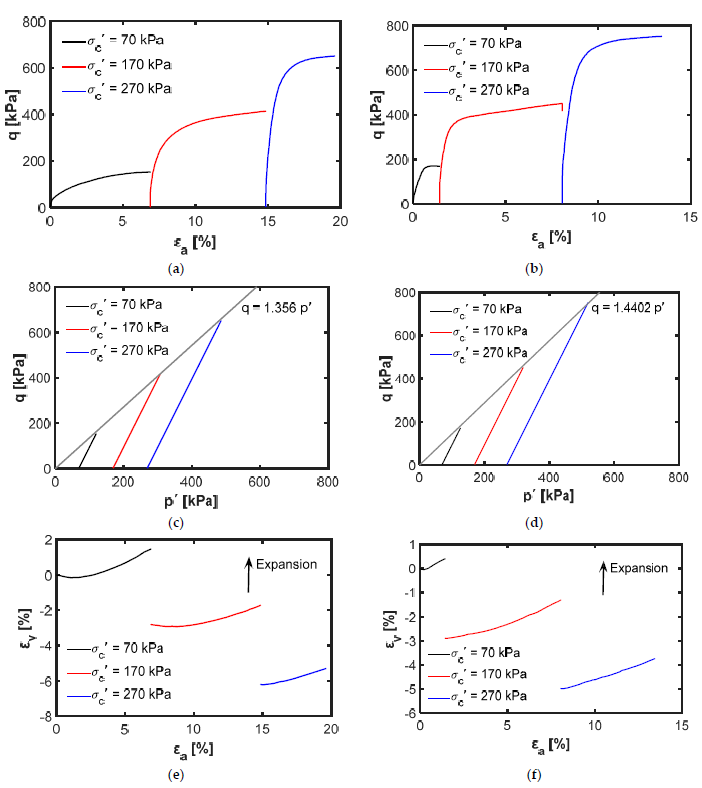

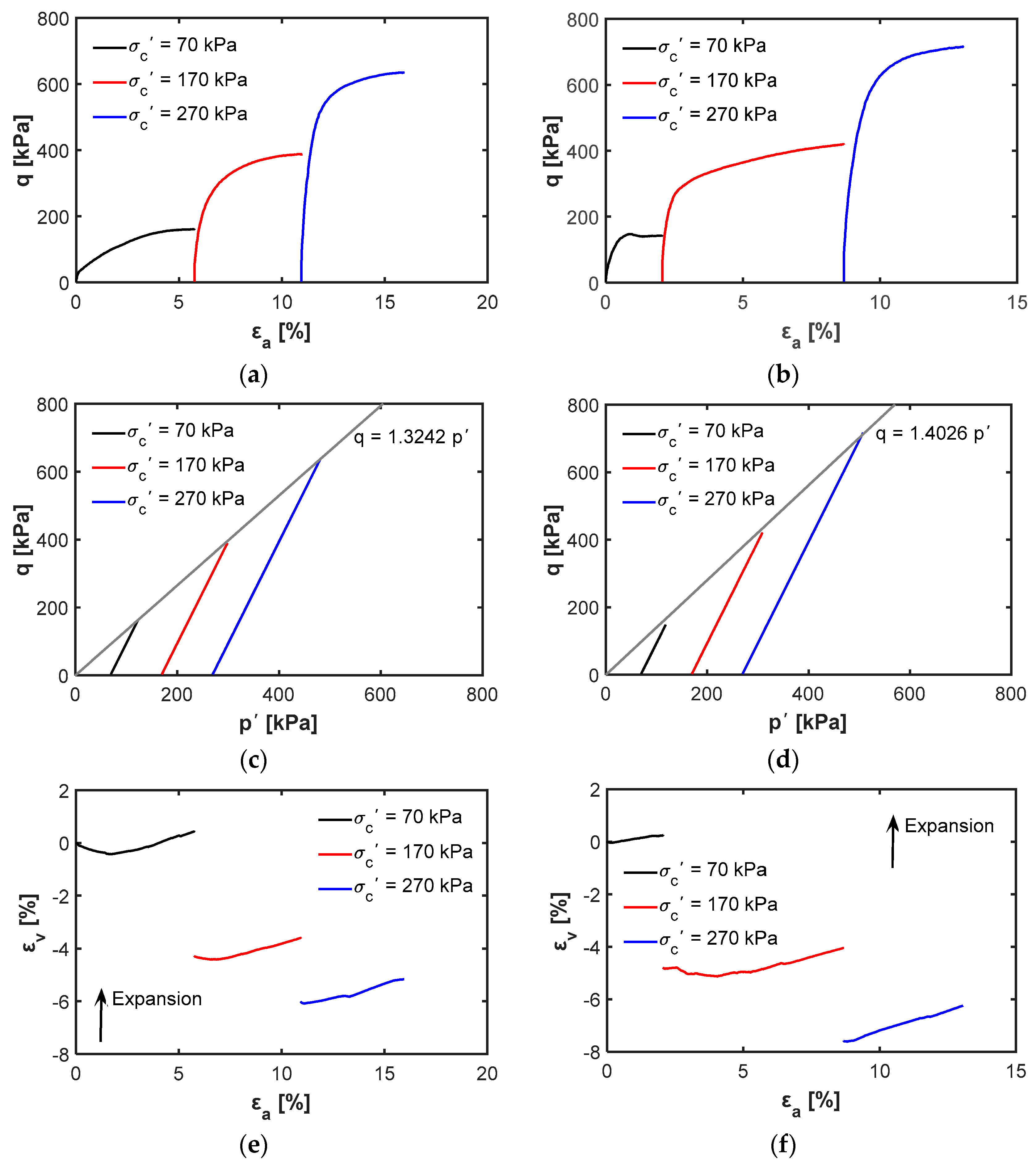

| Properties | oM | mM |
|---|---|---|
| Gravel, >2 mm (wt.%) | 2.85 | 4.72 |
| Sand, 0.063–2 mm (wt.%) | 50.98 | 57.08 |
| Silt, 0.002–0.063 mm (wt.%) | 43.20 | 37.39 |
| Clay, <0.002 mm (wt.%) | 2.97 | 0.81 |
| Porosity n (-) | 0.281 | 0.258 |
| Solids specific gravity Gs (-) | 2.650 | 2.696 |
| Bulk dry density ρd (kg m−3) | 1.905 | 2.000 |
| Natural gravimetric water content wn (%) | 14.68 | 9.52 |
| Liquid limit LL (%) | NA 1 | NA 1 |
| Plastic limit PL (%) | NA 1 | NA 1 |
| Plasticity index PI (%) | NP 2 | NP 2 |
| Grain diameter at 10% passing D10 (mm) | 0.0085 | 0.014 |
| Grain diameter at 50% passing D50 (mm) | 0.070 | 0.100 |
| Coefficient of uniformity Cu (-) | 10.588 | 10.000 |
| Coefficient of curvature Cc (-) | 2.092 | 1.127 |
| Lime content (%) | 6.67 | 12.56 |
| Unified soil classification system (USCS) | ML or CL 3 | SM or SC 4 |
| Temperature (°C) | oM | mM |
|---|---|---|
| 20 | 1.3560 | 1.4402 |
| 40 | 1.3544 | 1.4258 |
| 60 | 1.3242 | 1.4026 |
| Temperature (°C) | oM | mM |
|---|---|---|
| 20 | 33.57° | 35.50° |
| 40 | 33.54° | 35.17° |
| 60 | 32.85° | 34.64° |
Publisher’s Note: MDPI stays neutral with regard to jurisdictional claims in published maps and institutional affiliations. |
© 2021 by the authors. Licensee MDPI, Basel, Switzerland. This article is an open access article distributed under the terms and conditions of the Creative Commons Attribution (CC BY) license (http://creativecommons.org/licenses/by/4.0/).
Share and Cite
Hailemariam, H.; Wuttke, F. A Laboratory Study on the Shear Strength Behavior of Two Till Deposits from Northern Germany. Energies 2021, 14, 1692. https://doi.org/10.3390/en14061692
Hailemariam H, Wuttke F. A Laboratory Study on the Shear Strength Behavior of Two Till Deposits from Northern Germany. Energies. 2021; 14(6):1692. https://doi.org/10.3390/en14061692
Chicago/Turabian StyleHailemariam, Henok, and Frank Wuttke. 2021. "A Laboratory Study on the Shear Strength Behavior of Two Till Deposits from Northern Germany" Energies 14, no. 6: 1692. https://doi.org/10.3390/en14061692
APA StyleHailemariam, H., & Wuttke, F. (2021). A Laboratory Study on the Shear Strength Behavior of Two Till Deposits from Northern Germany. Energies, 14(6), 1692. https://doi.org/10.3390/en14061692





